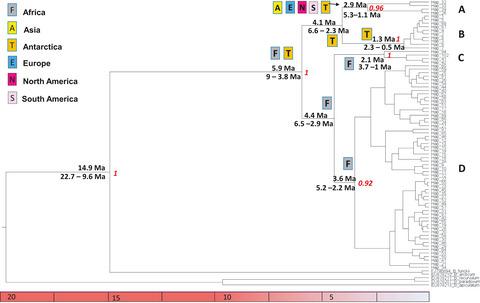当前位置:
X-MOL 学术
›
Ecol. Evol.
›
论文详情
Our official English website, www.x-mol.net, welcomes your
feedback! (Note: you will need to create a separate account there.)
Multiple colonization and dispersal events hide the early origin and induce a lack of genetic structure of the moss Bryum argenteum in Antarctica.
Ecology and Evolution ( IF 2.3 ) Pub Date : 2020-08-05 , DOI: 10.1002/ece3.6601 Serena Zaccara 1 , Jairo Patiño 2 , Peter Convey 3 , Isabella Vanetti 1 , Nicoletta Cannone 4
Ecology and Evolution ( IF 2.3 ) Pub Date : 2020-08-05 , DOI: 10.1002/ece3.6601 Serena Zaccara 1 , Jairo Patiño 2 , Peter Convey 3 , Isabella Vanetti 1 , Nicoletta Cannone 4
Affiliation

|
The dispersal routes of taxa with transoceanic disjunctions remain poorly understood, with the potential roles of Antarctica not yet demonstrated. Mosses are suitable organisms to test direct intra‐Antarctic dispersal, as major component of the extant Antarctic flora, with the cosmopolitan moss Bryum argenteum as ideal target species. We analyzed the genetic structure of B. argenteum to provide an evolutionary time frame for its radiation and shed light into its historical biogeography in the Antarctic region. We tested two alternative scenarios: (a) intra‐Antarctic panmixia and (b) intra‐Antarctic genetic differentiation. Furthermore, we tested for evidence of the existence of specific intra‐Antarctic dispersal routes. Sixty‐seven new samples (40 collected in Antarctica) were sequenced for ITS nrDNA and rps4 cpDNA regions, and phylogenetic trees of B. argenteum were constructed, with a focus on its Southern Hemisphere. Combining our new nrDNA dataset with previously published datasets, we estimated time‐calibrated phylogenies based on two different substitution rates (derived from angiosperms and bryophytes) along with ancestral area estimations. Minimum spanning network and pairwise genetic distances were also calculated. B. argenteum was potentially distributed across Africa and Antarctica soon after its origin. Its earliest intra‐Antarctic dispersal and diversification occurred during a warming period in the Pliocene. On the same timescale, a radiation took place involving a dispersal event from Antarctica to the sub‐Antarctic islands. A more recent event of dispersal and diversification within Antarctica occurred during a warm period in the Pleistocene, creating favorable conditions also for its colonization outside the Antarctic continent worldwide. We provide evidence supporting the hypothesis that contemporary populations of B. argenteum in Antarctica integrate a history of both multiple long‐range dispersal events and local persistence combined with in situ diversification. Our data support the hypothesis that B. argenteum has been characterized by strong connectivity within Antarctica, suggesting the existence of intra‐Antarctic dispersal routes.
中文翻译:

多次殖民和扩散事件掩盖了南极洲苔藓 Bryum argenteum 的早期起源,并导致其遗传结构的缺乏。
对具有跨洋分离的类群的扩散途径仍然知之甚少,南极洲的潜在作用尚未得到证实。苔藓是测试直接在南极洲内传播的合适生物体,是现存南极植物群的主要组成部分,而世界性苔藓Bryum argenteum是理想的目标物种。我们分析了B. argenteum的遗传结构,为其辐射提供了进化时间框架,并揭示了其在南极地区的历史生物地理学。我们测试了两种替代方案:(a) 南极洲内 panmixia 和 (b) 南极洲内遗传分化。此外,我们还测试了存在特定南极内部传播路线的证据。对 67 个新样本(其中 40 个在南极洲采集)进行了 ITS nrDNA 和 rps4 cpDNA 区域的测序,并构建了B. argenteum的系统发育树,重点关注其南半球。将我们的新 nrDNA 数据集与之前发布的数据集相结合,我们根据两种不同的替代率(来自被子植物和苔藓植物)以及祖先面积估计来估计时间校准的系统发育。还计算了最小跨越网络和成对遗传距离。B. argenteum在起源后不久就可能分布在非洲和南极洲。它最早在南极洲内的扩散和多样化发生在上新世的变暖时期。在同一时间尺度上,发生了一次辐射,涉及从南极洲到亚南极岛屿的扩散事件。最近的一次南极洲内的扩散和多样化事件发生在更新世的温暖时期,这也为其在全世界南极大陆以外的殖民化创造了有利的条件。我们提供的证据支持这一假设,即南极洲的当代银芽孢杆菌种群融合了多次远程扩散事件和局部持久性与原地多样化的历史。我们的数据支持这样的假设:银芽孢杆菌在南极洲内具有很强的连通性,这表明南极洲内部存在传播路线。
更新日期:2020-08-28
中文翻译:

多次殖民和扩散事件掩盖了南极洲苔藓 Bryum argenteum 的早期起源,并导致其遗传结构的缺乏。
对具有跨洋分离的类群的扩散途径仍然知之甚少,南极洲的潜在作用尚未得到证实。苔藓是测试直接在南极洲内传播的合适生物体,是现存南极植物群的主要组成部分,而世界性苔藓Bryum argenteum是理想的目标物种。我们分析了B. argenteum的遗传结构,为其辐射提供了进化时间框架,并揭示了其在南极地区的历史生物地理学。我们测试了两种替代方案:(a) 南极洲内 panmixia 和 (b) 南极洲内遗传分化。此外,我们还测试了存在特定南极内部传播路线的证据。对 67 个新样本(其中 40 个在南极洲采集)进行了 ITS nrDNA 和 rps4 cpDNA 区域的测序,并构建了B. argenteum的系统发育树,重点关注其南半球。将我们的新 nrDNA 数据集与之前发布的数据集相结合,我们根据两种不同的替代率(来自被子植物和苔藓植物)以及祖先面积估计来估计时间校准的系统发育。还计算了最小跨越网络和成对遗传距离。B. argenteum在起源后不久就可能分布在非洲和南极洲。它最早在南极洲内的扩散和多样化发生在上新世的变暖时期。在同一时间尺度上,发生了一次辐射,涉及从南极洲到亚南极岛屿的扩散事件。最近的一次南极洲内的扩散和多样化事件发生在更新世的温暖时期,这也为其在全世界南极大陆以外的殖民化创造了有利的条件。我们提供的证据支持这一假设,即南极洲的当代银芽孢杆菌种群融合了多次远程扩散事件和局部持久性与原地多样化的历史。我们的数据支持这样的假设:银芽孢杆菌在南极洲内具有很强的连通性,这表明南极洲内部存在传播路线。

















































 京公网安备 11010802027423号
京公网安备 11010802027423号